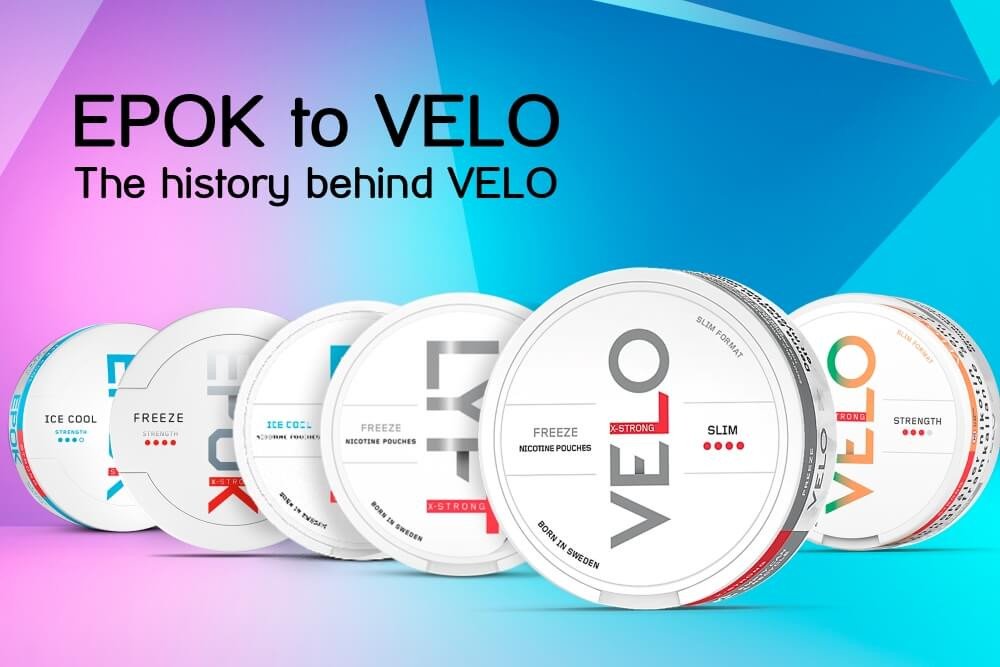EPOK to VELO: The history behind VELO

Nicotine pouches are one of the most popular smokeless products on the market. At the forefront of the sector is VELO – a BAT-made brand that was once known as EPOK . This bestselling line went through several interesting transitions from the late 2010s to the early 2020s. So, let’s take a look at its timeline, and explore how it differed at each stage.
What was EPOK snus?
EPOK was a brand that many consider to have kickstarted the global transition from snus to nicotine pouches. It was one of the first all-white products, made by bleaching the tobacco and removing any impurities, resulting in a product that offered a longer-lasting, lower drip experience. The line was created by Winnington – a Swedish manufacturer that British American Tobacco (BAT) went on to acquire in 2017.
Why was EPOK so popular?
EPOK snus was an incredibly innovative product for its time. It pushed the boundaries of traditional snus’ capabilities, giving it a modern, ergonomic edge. Like any new release, enthusiasts had to take a punt and try it to see if they liked it – and they sure did! But why? Well, EPOK presented several pros over its old-school counterpart, including:
- A longer-lasting release
- Significantly reduced drip
- Minimal chances of stained teeth and/or bad breath
- New and unique flavour profiles
EPOK fades, VELO emerges…
In light of the Tobacco Master Settlement Agreement of 1998, and the gradual decrease in tobacco consumption, manufacturers began working on ways to deliver nicotine without tobacco. As such, EPOK seemingly evaporated into thin air, and consumers were introduced to two new tobacco-free lines, LYFT and VELO.
BAT’s tobacco-free twist took effect in 2018. The pouches of both brands were identical. However, which design you got depended on where you lived:
VELO was released and sold in the US.
LYFT was released and sold in Europe.
Both types took off, and BAT had a bit of a sticky situation on its hands. To create a truly global, instantly identifiable product, it needed to market one brand, not two.
VELO takes over, LYFT relaunches
In 2019, BAT announced it would replace VELO with LYFT in every country, excluding Sweden, by 2020. But what did that mean? Well… LYFT relaunched as its own line, bringing an influx of new portions, flavours and strengths to the market. As such, BAT could cater to a larger cohort and continue to retain its top-dog status.
How do VELO and LYFT differ today?
Both brands prosper globally, with VELO being a clear leader in the UK scene. Take a look at a summary of their differences, below.
|
Category |
VELO |
LYFT |
|
Flavor |
? VELO has a flavour profile fitting into all categories. |
? LYFT has a smaller range of flavours. The tasting experiences LYFT offers are far more premium. |
|
Nicotine Strength |
? 4 - 17 mg/portion |
? 6 - 14 mg/portion |
|
Format |
? Mini & Slim |
? Mini & Slim |
Looking for more information on these brands? Head over to our blog for an in-depth VELO vs LYFT guide!
How is VELO different from EPOK?
What started as a semi-traditional tobacco product has now developed into a fit-for-modern-life alternative. In comparison to EPOK, VELO is:
- 100% tobacco-free
- More diverse in flavours, strengths and formats
- Widely available
- Legal in many countries around the world
- MAOI-free
MAOIs: None in VELO, some in EPOK – why?
As you may know, nicotine is an addictive substance. However, there are proteins in our body called MAOIs, which, when inhibited – are linked with increasing the addictive potential of nicotine. But here’s the good thing – these inhibitory effects aren’t associated with nicotine pouches, just snus. This is because of the tobacco. EPOK contained small amounts of white-washed tobacco and – therefore, some MAOIs. VELO, on the other hand, has none!
What came before nicotine pouches? Nasal snuff and snus
When did the first nicotine pouch come out? The answer is 2008! Back then – they were deemed medicinal nicotine replacement products, or ‘NRT’. But what about before? What was on the market then?
|
Product Name |
What is it? |
How is it used? |
Pros |
Cons |
|
Snuff (1561) |
Finely ground tobacco, sometimes with flavourings added. |
Insufflated into the nasal cavity. |
Rapid onset of effects |
Nasal damage, irritation and sneezing. |
|
Snus (1700s) |
Snus is finely ground tobacco that’s steam pasteurised. It’s either portioned or loose, moistened and flavoured. |
Orally, the same as nicotine pouches. |
Nuanced flavours, discreet |
Potential for stained teeth and moderately bad breath. |
|
Chew (1400s) |
Chew is cured tobacco that comes as loose leaf, pressed into a plug or twisted to form a roll. |
Between the cheek and gums. |
Immersive, engaging |
Severe gum irritation and jaw pain. Stained teeth and bad breath. |
|
Dip (1800s) |
It is finely processed tobacco that has been cured and fermented. |
In the lower lip. |
Bold flavours, powerful nicotine release |
Severe gum irritation and jaw pain. Stained teeth, bad breath and spitting. |
 In English
In English 



